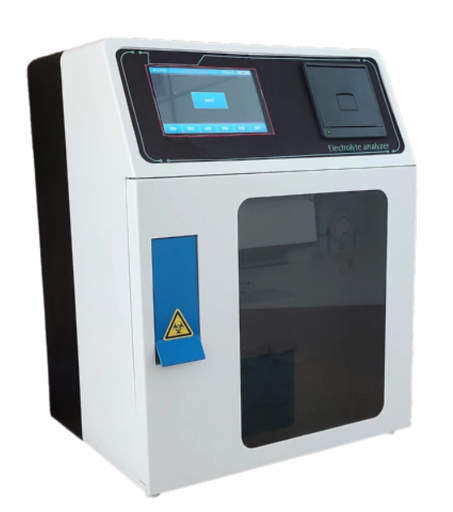Electrolyte analyzers play a vital role in modern healthcare, providing quick and reliable measurements of key electrolytes such as sodium, potassium, and chloride. These compact devices are indispensable in clinical laboratories and point-of-care settings, offering actionable insights for diagnosing and monitoring various health conditions. If you’re exploring this topic, let’s dive into the essentials of electrolyte analyzers, their applications, and the innovations shaping the field.
What is an Electrolyte Analyzer?
An electrolyte analyzer is a medical device designed to measure electrolyte levels in biological samples like blood, serum, and plasma. These devices predominantly use ion-selective electrode (ISE) technology to quantify specific ions.
Key Features:
- Speed: Results are typically available within 1–3 minutes.
- Accuracy: Error margins are minimal when properly calibrated.
- Compact Design: Ideal for use in both large hospitals and smaller clinics.
Did You Know?
According to a 2023 study by Global Market Insights, the global electrolyte analyzer market is expected to grow at a CAGR of 4.8%, reaching $1.2 billion by 2028. This underscores the increasing demand for these devices in healthcare settings.
Clinical Applications
Electrolyte imbalances can be life-threatening, making these analyzers critical in medical diagnostics. Some key applications include:
- Emergency Rooms: Monitoring electrolyte shifts in trauma or dehydration cases.
- Neonatal Care: Managing electrolyte disturbances in premature infants.
- Chronic Disease Management: Regular checks for patients with kidney disease, diabetes, or heart failure.
Case Example:
A study published in The American Journal of Clinical Pathology revealed that timely detection of hyperkalemia (high potassium levels) using point-of-care electrolyte analyzers reduced mortality rates by 15% in critical care units.
Accuracy and Reliability
Electrolyte analyzers are designed to deliver reliable results, but accuracy can be influenced by various factors such as sample contamination or improper maintenance. Routine calibration ensures consistent performance.
Comparison Table: Electrolyte Analyzer vs. Manual Methods
| Feature | Electrolyte Analyzer | Manual Lab Tests |
|---|---|---|
| Turnaround Time | 1–3 minutes | 1–2 hours |
| User Expertise | Minimal | Advanced Skills |
| Error Rate | Low (1–2%) | Moderate (5–7%) |
Maintenance and Calibration
Routine Maintenance Tips:
- Clean Electrodes Regularly: Prevents buildup that could affect readings.
- Check Reagent Levels: Insufficient reagents can yield errors.
- Software Updates: Keep firmware up-to-date for optimal functionality.
Pro Tip:
Perform calibration at least once daily if the device is in continuous use. For low-usage settings, weekly calibration may suffice.
Choosing the Right Analyzer
Selecting the right electrolyte analyzer depends on the needs of your facility. Factors to consider include:
- Sample Throughput: High-volume labs may require automatic models.
- Parameters Measured: Some devices can also measure pH and blood gases.
- Budget Constraints: Entry-level models are available for smaller clinics.
Have questions? We offer free consultation.
Automatic vs. Semi-Automatic Models
Automatic analyzers are faster but costlier, while semi-automatic models require manual intervention, making them more affordable for low-budget setups.
Advanced Features and Capabilities
Modern electrolyte analyzers are packed with features that go beyond basic measurements:
- Multifunctionality: Many devices now analyze pH, CO2, and hematocrit levels.
- Connectivity: Integration with Laboratory Information Systems (LIS) allows seamless data sharing.
Real-World Example:
The Siemens RAPIDLab 348EX not only measures electrolytes but also provides blood gas analysis, reducing the need for multiple devices.
Common Challenges and Solutions
Even the most advanced devices are not immune to issues. Some common problems include:
- Electrode Fouling: Caused by protein or lipid deposits.
- Solution: Regular cleaning with recommended solutions.
- Sample Clotting: Results in inaccurate readings.
- Solution: Use anticoagulated samples to prevent clotting.
Best Practices for Avoiding Errors:
- Ensure sample collection tubes are compatible with the analyzer.
- Train staff on proper sample handling and device operation.
Recent Technological Advancements
The field of electrolyte analysis has seen remarkable advancements, such as:
- Maintenance-Free Electrodes: Reduce downtime and operational costs.
- AI Integration: Predictive analytics to flag abnormal trends in results.
Industry Insight:
A 2024 Frost & Sullivan report highlighted that AI-powered electrolyte analyzers improve diagnostic accuracy by 20%, particularly in chronic disease management.
Conclusion
Electrolyte analyzers are indispensable in healthcare, combining speed, accuracy, and versatility. By understanding their capabilities and ensuring proper maintenance, healthcare providers can enhance diagnostic precision and patient outcomes. As technology continues to evolve, the future of electrolyte analysis promises even greater efficiency and innovation.
→Click here to learn more about our Electrolyte analyzer
or
Key Takeaways:
- Routine maintenance ensures consistent accuracy.
- Choosing the right model depends on your facility's needs and budget.
- Staying updated with advancements enhances the utility of these devices.
